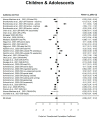Changes in Physical Activity Patterns Due to the Covid-19 Pandemic: A Systematic Review and Meta-Analysis
- PMID: 35206434
- PMCID: PMC8871718
- DOI: 10.3390/ijerph19042250
Changes in Physical Activity Patterns Due to the Covid-19 Pandemic: A Systematic Review and Meta-Analysis
Abstract
With the outbreak of the Corona Virus Disease 19 (Covid-19) in late 2019, governments increasingly imposed containment strategies, including social distancing as well as restricted population movement, potentially having negative impacts on mental and physical health. A growing number of studies have examined the impact of the pandemic on different facets of physical activity (PA); an overview combining these (mixed) results, however, is missing. Thus, the objective of this systematic review and meta-analysis was to investigate whether and to which extent PA changed from before to during the Covid-19 pandemic, taking age, gender, and measurement method into account. The literature search was conducted using PubMed, Web of Science, and Scopus. Results of the main characteristics were descriptively synthesized and analyzed in a meta-analysis quantifying effects of the pandemic on PA divided by age groups, with additional subgroup analyses of the characteristics age, gender, and measurement method being narratively synthesized. Overall, 57 studies with a total sample size of 119,094 participants (N between 10 and 60,560 subjects) from 14 countries worldwide with participants aged between four and 93 years were included. Thirty-two studies revealed a significant decline in PA, whereas only five studies found a significant increase in PA during the Covid-19 pandemic. Fourteen studies revealed mixed results. PA decreased in all age groups, independent of gender. Most self-reported and all device-based measurement methods showed a reduction in PA. However, effects were not found to be significant in all age groups. Nevertheless, the declining trend should be noted and governments should strive to enable PA within periods of pandemic restrictions, or promote alternatives such as digital training to avoid negative health consequences within the population.
Keywords: Covid-19; SARS-CoV-2; coronavirus; exercise; physical activity; training.
Conflict of interest statement
The authors declare no conflict of interest.
Figures





References
-
- World Health Organization Listings of WHO’s Response to COVID-19. [(accessed on 5 May 2021)]. Available online: https://www.who.int/news/item/29-06-2020-covidtimeline.
-
- World Health Organization WHO Announces COVID-19 Outbreak a Pandemic. [(accessed on 12 February 2022)]. Available online: https://www.euro.who.int/en/health-topics/health-emergencies/coronavirus....
-
- Johns Hopkins University, Center for Systems Science and Engineering COVID-19 Dashboard. [(accessed on 12 February 2022)]. Available online: https://gisanddata.maps.arcgis.com/apps/dashboards/bda7594740fd402994234.... - PMC - PubMed
-
- European Centre for Disease Prevention and Control Data on Country Response Measures to COVID-19. [(accessed on 28 May 2021)]. Available online: https://www.ecdc.europa.eu/en/publications-data/download-data-response-m....
Publication types
MeSH terms
LinkOut - more resources
Full Text Sources
Medical
Miscellaneous

